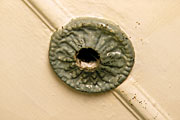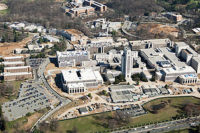And yet, only a few years before, the mansion and its grounds were falling to ruin. Many outbuildings were already gone. The federal government, preoccupied with the looming clouds of war, could not buy the estate from the Washington family.
In 1853, Ann Pamela Cunningham launched a nationwide campaign to purchase and preserve George Washington's home. The nation responded, and five years later the Mount Vernon Ladies' Association that Cunningham founded was able to buy the estate. For more than 140 years now, the association has held Mount Vernon in trust, caring for it, authentically restoring its original appearance, and adding outreach and education programs, estate events and activities, and amenities for the more than one million people who annually visit the nation's most popular historic home.

Fire: A Continuing Concern
When George Washington lived at Mount Vernon, leather fire buckets were considered the most effective way to fight fire. Mount Vernon was well supplied with them, and some are still on display.Soon after the association acquired Mount Vernon, cisterns and force pumps were installed for fire fighting. About 1870, fire apparatus and pumps were purchased for on-site use, and an in-house fire department was first organized. That fire department still exists, with the director of operations and maintenance as fire chief, and 13 members of the 60-person Operations and Maintenance department serving as standby firefighters in addition to their regular jobs. Five of them, who live on the estate, handle the nighttime fire duty schedule. A well-trained, 25-member volunteer EMS First Responder group is also available for emergency care.
Mount Vernon's Engine Company 468 is considered part of the Fairfax County Fire and Rescue Department, and handles frontline response to fire emergencies, backed up by the county firefighters. Fairfax also supplied the modern pumper used at Mount Vernon.
The board of the Mount Vernon Ladies' Association relies on the Operations and Maintenance department to suggest the appropriate measures to protect the facility, its visitors, and employees. Over the years they have been very willing to listen to suggestions of better new technology to make Mount Vernon safer. Every member of the association and staff wants to provide the best protection to preserve the historic site they all love.
Water sprinklers and high-pressure hoses are not considered appropriate for historic buildings, and especially not the mansion house at Mount Vernon. Not only would water discharge cause great damage to the house and its furnishings, but installation of the piping would deface the building which, of course, was never designed for between-floor or in-wall services. So in addition to the careful concern of the staff, the first line of defense for the house and throughout the estate is a system of fire detectors to summon the on-site firefighters.

Legacy Halon for Fire Suppression
In the mansion, the ultimate defense is a building-wide network of 37 cylinders, each containing from 20 to 250 pounds - a total 2,400 pounds - of DuPont Halon 1301 fire suppression agent. The Halon cannot be automatically triggered. Its release can only occur manually at the decision of the chief firefighter.Rather than extinguishing a fire the way water does, Halon 1301 prevents the combustion process. It stops fires from burning within 10 seconds of the manual release of the agent. And, since Halon 1301 is a gas, there are no chemicals to clean up or water damage to repair.
However, to adequately suppress the fire, the protected area must be sealed so the gas will not escape. The individual rooms in the house cannot be sealed because of the flow of visitors. Therefore, the entire 37 cylinders will be discharged, simultaneously if necessary, to suppress any fire in the house.
The Halon system was installed in the mid-1970s. As a fluorocarbon, Halon is no longer manufactured for fire suppression use, but the cylinders - which have never needed to be discharged - are kept full and a limited replacement supply is available. It is hoped that the Halon system will remain in good working order for some time. The replacement Siemens Cerberus FM200 suppression agent is, however, being tested in some modern buildings on-site.

Installing the Halon
Installation of the Halon system was a marvel of archaeological and conservation integrity. The prime concern was to have the absolute minimum effect on the house. Great pains were taken to avoid damage, including preparation of comprehensive new drawings and x-raying walls and ceilings to determine the least intrusive route.
The second important concern was how much damage might be caused by discharge of the system. Halon 1301 gas is stored under pressure. This pressure is used, however, in order to quickly discharge the gas. The force of the discharge can damage furnishings and other decorations. In order to further protect the building, the discharge nozzles were designed to operate with a minimum pressure. The entire system was tested to ensure that it could suppress a fire while maintaining the safety required.

Evolution of Fire Detection Arrangements
The first automatic fire detection system at Mount Vernon was an early 1930s heat-detection system based on bimetallic cabling run through the house. In the 1970s, this was replaced by a Pyrotronics System 3 ionization-type smoke detection system. The detectors were installed in the mansion, the overseer's house, and the kitchen building.Smoke detector heads are designed to be relatively unobtrusive, but Mount Vernon's trustees refused to allow such modern equipment to be anywhere in sight. Instead of mounting smoke detectors on the ceiling, Siemens Cerberus designed special air-sampling systems to detect smoke. These systems use a very high-sensitivity detector stored out of sight. A fan draws air from the protected area - through a series of tubes and pipes - to the detector. A large area can be protected by one detector, and the increased sensitivity to smoke entering one tube will cause an alarm as though a smoke detector head were located in the room.
The tubes are as small as .25 in. in diameter. Therefore, they can protrude into a room and be hidden in ceiling ornamentation and other unobtrusive locations. Trained fire professionals are hard-pressed to locate them while touring the house.
The Next Generation
When the next generation of fire protection was recently installed, the Siemens Cerberus multiplexed MXL system with addressable smoke detectors was extended throughout the estate. "Intelligent" detectors now cover the entire exhibition area, including stables, horse barns, cellars, and basements - a total of about 50 buildings. The system in the mansion continues to employ the original air-sampling arrangements to bring room air to concealed, high sensitivity detectors.In some of the buildings - the treading barn, the cellars, and the greenhouses, for example - the detectors are exposed to rigorous, harsh environments open to dust, humidity, and extremes of cold and heat. The Operations and Maintenance department has found that intelligent detectors, well maintained, have been very successful in avoiding false alarms. However, the renovated Mount Vernon Inn, slated to reopen this month, has specified Siemens, Cerberus FirePrint application specific detectors.
FirePrint is unique in that it can identify fires quickly without being fooled by those things - such as dust and humidity - that often cause false alarms. Over a range of 11 different applications, this detector understands the fire risk in the protected area. It constantly analyzes the air and detects, but ignores, false, "fire-like" events. When a "real" fire occurs, the FirePrint responds without delay.
State-of-the-Art Controls
The most recent addition to Mount Vernon's fire protection system is a state-of-the-art networked control system. Seven new MXL control panels with graphic user interface (GUI) screens are networked into a system with touch capability. In one of the first applications of MXL system wide-area networking, a mile-long fiber-optics communications bridge connects the seven MXL control panels throughout the 500-acre estate. When connecting systems over such a large area, the possibility of electrical storms may place this electrical system at risk.The fiber-optic cable greatly reduces this risk. Additional lightning suppression devices at each building absorb the energy of nearby strikes so that the system can continue to operate - even under these severe conditions. The central command center is located in the former gardener's house, which serves as the estate's 24-hour nerve center. In addition to the main MXL controls, operators can monitor 65 CCTV cameras covering the entire property inside and out, from river shore to mansion, main gate, and restaurant.
Therefore, if a fire alarm is received, the area can be immediately surveyed to assess the risk. A fire alarm coming in here alerts the Fairfax County fire department and triggers immediate dispatch of the on-site fire company, which is in radio contact with the incoming units.

